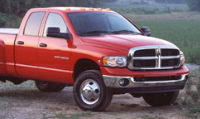Tire Pressures
#1
Heading back to Florida, looking forward to the road trip in the new truck. Looking for some input on tire pressures for my 20's.
WhenI picked it up from the dealer,they had 42psi in them. Sticker on the inside of the driver door says 35 psi. Somewhere in between? Personally, I set them all at 38psi. Is there a rule of thumb, whats better for fuel economy? Ride? Tire wear? Thanks.
BTW, gas station mechanic said in the fifties...???
WhenI picked it up from the dealer,they had 42psi in them. Sticker on the inside of the driver door says 35 psi. Somewhere in between? Personally, I set them all at 38psi. Is there a rule of thumb, whats better for fuel economy? Ride? Tire wear? Thanks.
BTW, gas station mechanic said in the fifties...???
#3
#6
The rating on the tire is the max pressure for that tire on any vehicle.
The rating on the door is what Dodge recommends due to the weight of the truck, etc.
I actully set mine around 31 because they ride better and the center of the tire doesn't wear faster than the edges.
The rating on the door is what Dodge recommends due to the weight of the truck, etc.
I actully set mine around 31 because they ride better and the center of the tire doesn't wear faster than the edges.
#7
Sorry, I gotta agree, ignore the number on thetire. That number is there for nothing more then to show what pressure is need for that tire to carry it's max load. This is just me saying this, every "professional" tire shop, consumer website, even tire manufacture will say the same thing, go with what is on the door of your truck. Your door says 35? Run 35 and bump it to 38-40 for long hwy trips for better mileage but staying that high all the time will wear out the center tread very quickly. Simply math: My tires are rated to carry 2600lbs each(stock HP's)at max pressure. That's 10400 lbs. those 4 tires could carry!The max gross weight of my truck is about 6600 lbs. Slightly more then 60%. So why would I put 100% max in the tires? That's the ideal way to set your pressure: Load it up the way you drive most of the time(# of passenges, cargo, etc.), weigh each corner, add it up,and get a ratio between your tires max weight/max pressure, your weight/ideal pressure.
Trending Topics
#8
The number on the truck is the one you ignore. Automakers pick that number to give you a soft cushy ride, not to get the most out of your tires. You think the OEM recommendation means anything when you change the tires? Their number is certainly safe - that is, you won't have a blowout because of low pressure, but you won't be getting the most grip out of the tire.
I've run the tires on my trucks at 38 psi for years and never had an issue with uneven wear. 30-32 psi may have been the norm in the 80s but modern tires drive better with more air. Try different pressures - it won't hurt anything and you'll know what you're happiest with.
If 38 psi causes the center of the tire to wear more than the rest, odds are you have too wide a tire for the rim.
I've run the tires on my trucks at 38 psi for years and never had an issue with uneven wear. 30-32 psi may have been the norm in the 80s but modern tires drive better with more air. Try different pressures - it won't hurt anything and you'll know what you're happiest with.
If 38 psi causes the center of the tire to wear more than the rest, odds are you have too wide a tire for the rim.
#9
Sorry John, you are mistaken.
From Consumer Reports;
Check tire air pressure. Once a month and before any extended road trips, use an accurate tire-pressure gauge to check the inflation pressure in each tire, including the spare. Do this when the tires are cold (before the vehicle has been driven or after no more than a couple of miles of driving). Use the inflation pressure recommended by the vehicle’s manufacturer, not the maximum pressure embossed on the tire’s sidewall. The recommended pressure is usually found on a placard on a front doorjamb, in the glove compartment, or in the owner’s manual. Also be sure to inspect tires for abnormal or uneven wear, cuts, and any sidewall bulges you can see.
http://www.consumerreports.org/cro/c...ire%20pressure
If you change your tires to similar ones, then use the number on the vehicle, otherwise you have to go with wear patterns, never use maximum pressure on the tire.
From Consumer Reports;
Check tire air pressure. Once a month and before any extended road trips, use an accurate tire-pressure gauge to check the inflation pressure in each tire, including the spare. Do this when the tires are cold (before the vehicle has been driven or after no more than a couple of miles of driving). Use the inflation pressure recommended by the vehicle’s manufacturer, not the maximum pressure embossed on the tire’s sidewall. The recommended pressure is usually found on a placard on a front doorjamb, in the glove compartment, or in the owner’s manual. Also be sure to inspect tires for abnormal or uneven wear, cuts, and any sidewall bulges you can see.
http://www.consumerreports.org/cro/c...ire%20pressure
If you change your tires to similar ones, then use the number on the vehicle, otherwise you have to go with wear patterns, never use maximum pressure on the tire.
#10



